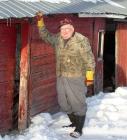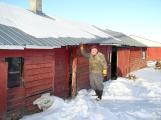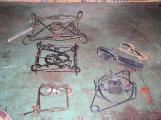2
The first visitors to the former Osgoode Township (Ward 20, City of Ottawa since January 1, 2000) came to harvest the furs, especially beaver, and to harvest the pine along the shores of the Castor River and its branches, as well as along the Rideau River which geographically marks the township's western boundary. The dense forests, the thick undergrowth, and the swampy marshes of the mainly flat land provided an ideal home for an abundance of wildlife. Early accounts indicate there was a large population of beaver, otter, muskrats, deer, foxes, raccoons and wolves. By 1927, the year that the first settlers established their homes in what was to become Osgoode Township, the beaver population, although still fairly large, had diminished greatly due to the aggressive trapping of the Indians, the North-West Fur Trade Company and the Hudson Bay Company.As the population of Osgoode Township grew, the forested areas diminished as land was cleared for farming, and a number of strategic ditches were dug to drain many of the swampy areas. As a result, a large number of the animals living in this habitat retreated to the stream and river banks. Hunting deer continued as a food source, and trapping the many varieties of fur-bearing animals became a means of gaining extra income, usually as a part-time activity connected with regular farming operations.
One of these present day trapper/farmers is Clarence Mussell whose dairy farm, located on the south half of Lot 30 Broken Front, is situated on the east side of the River Road, a few kilometres south of the Kars Bridge. His farm, called "Overlook Farms", is appropriately named in that one can sit in his comfortable living room and overlook the Rideau River just across the road, and at the same time, view James' Island which is situated midstream directly opposite the farm gate. Clarence's son Paul and his family run a dairy farm on the River Road a short distance north of his dad's place. Like his father and his grandfather before him, Paul, too, is actively engaged in trapping. Paul's trapping"territory" extends along the Rideau River between Manotick and Burritt's Rapids. Paul's sons Ryan and Ben are learning the trade from both their father and their grandfather, and according to grandpa, they're pretty good at it already.
Clarence Mussell, born in 1926, became involved in trapping as a teenager after watching his father Allan and his older brother Stanley skinning muskrats and listening to the many interesting and detailed stories of their daily hunting adventures. Clarence's "formal" education ended after completing Grade 8 at S.S. (School Section) #2 Osgoode, or Rideau Hill School as it was then called. The one room schoolhouse was located opposite the present day United Church's Rideau Hill Camp. Ray's older brother would join the Air Force and Clarence was needed at home to help run the family farm.
Interviewer: Ron Isaac & Doug Hughes
Date: January 21, 2004
Subject: Hunting and Trapping
Why would you want to trap?
You must remember that my father, he was a trapper and as children we would go out to the house where he was skinning with a knife and listen to his stories and watch him skin. As we got a little older we were now 5, 6 ,7 years old we he would let us get the small 'rat if we could get a small 'rat to practice on. So and then of course as we got a little older we kept going and our first episode was to trap in the ditch, our favourite ditch, there really wasn't that many muskrats in it but our father would slip by when we didn't know it and when we came home from school there was a 'rat in our trap. Dad said I think you'd better check you trap because I think I saw it move last night and we rushed back and saw the muskrat in our trap and dollar value they were going at as I got older war was on in 1941 and I dad took me out of school to work on the farm and I just had to have a little place to trap so at 15 I was able to get a license and start to trap.
You had to have a licence?
It was $5 and I got 30 muskrats that first year trapping right out in front of here and I they were $2 a piece and the Jews used to come around and buy them and I was just like the bank when they came around, it was like the bank when they came around because you could get cash and they always gave cash three $20 dollar bills I got for my muskrats.
What year would that have been?
I think that was 1945 - 1946. That was good money, it was like gold and I held onto those $20 dollar bills for a long time before but I stayed at home and I never went back to school after that and.
So what grade did you leave school then?
Eight, I finished grade 8 and started grade 9 and I went West and did harvesting after the war was over in 1945 my brother got home from the Air Force and he stayed here and I went west on the train with the harvesting crew. My younger brother was at home too. I had a great time, I was 2 months out west and worked on the harvest and I went to visit some of my relatives and I got home and I was like a new person, I had done some travelling. So anyway dad had been scouting more or less and heard of this farm in Oxford Mills this great 'rat ranch on some property, Kemptville Creek went on up by it and so I think it was 1946 we decided to buy it and we bought it in February so we could trap in March, you see, when the flood waters in the spring were there. He was going to trap up there and at the time, of course he was around the island and a big area here but then the others trappers could trap here to. So they could trap any place you bought a license for $5.00 and you could trap anywhere. So most of the farmers were trapping, nearly everybody was trapping along the river, you would have a little block and people would go where they wanted to go. We started up in Oxford Mills and it was Sunday and the sun was beaming down and the water was coming up. You could look out the window and I'd get up look out from bed and I could see out the window and there was a damn bunch of 'rats I could see just out the window and I said dad lets go. And he said we're not trapping on Sunday. Oh yes, he was very strict you know. So Monday morning, of course, we exploded out there and set our traps and the oldest brother was here on the Rideau and he wasn't really trapping and phones, he said dad get back home because the other guys were in on our territory and the cream of the rats were there first. So he picks up his stuff and comes home and says you'll have to stay there so I stayed and the farmer we bought it from was living in half the house, Manson McNeil and his wife Muriel, and they were very good to me but he had a hernia operation and he never really got over it but the was good to me he would say, "Well look it, that under a certain tree there is a stump where you will find them (the muskrats) but they were all closed down because he would go around every fall and lift them up, you see, so the flood in the spring. So the 'rats wouldn't be drowned out you would always put a he had put them over the creek so the 'rats climb on them. He would always say "Did you get that certain stump? Did you get that certain stump?"and I did. It turned out that my dad, he was anxious to get back up and so he trapped here and he got 200 or so here and he came back here and back up he came to trap he had Stevens Creek, he had this side of the river and he had the island. And then other trappers had other areas but it was mutual, if a guy came in and wanted to trap he could trap anywhere he wanted to. So some places there were more trappers than in others.
What island was that?
James' Island, now Petric's got it to tell the truth, George Petric
It always flooded. That has grown up in my time, that was all fields, that would all flood around it So he come up to Oxford Mills and I had just been out trapping and was just about done and when they run they run and when the mating season is over its over. The people in the house were very scared of people stealing so I dried the 'rats in the house, I dried them on the stairway, I dried them everywhere, and I tell you my sister came out to see me at Easter and we sat in the door where I had to skin cause they were scared of stealing so it smelt horrible and she couldn't stand it. But after three days, Friday, Saturday and Sunday she got used to it, she didn't smell them either. So anyway the buyer came around and I always asked and I had them in boxes and he was grading them in piles around the floor here and dad come through the door his eyes just stuck out and he was going to triple the price of rats, rats was up you see, and he kicked them all in a pile and said pay that boy $3.85 or whatever it was and he never said a word and he just put them back in the box. They had money, every time, rolls of it, big rolls. Anyway he was buying so he got out this roll of bills and he payed me $ 840. We had only paid $ 6,400 for the farm and here we had $840 for the first catch of the muskrats and my older brother took over that farm and trapped every year since 'til 2000. We can normally get about 200 - 300 just like that. I came back here with dad and trapped here and as he got older I kept doing more and about 1950 I took over dads trapping area and he did a little trappin' here and he helped with the ploughing and stuff like that and I went and did it myself, it was dangerous since you had a little canoe.
We had a trapper in Osgoode, Jimmy Connors, and he made boats, row boats you know. You could take him white pine boards 12 or 14 feet long, 12 inches wide, take it into him and he would make a form what ever size you wanted. He would make you a canoe or a row boat, what ever you wanted, I wanted a row boat, I wasn't a decent swimmer, I didn't enjoy the water at all. To get to the island the river was flooded and the ice was all there in spring so the only way you could get to the island was to take the canoe with you, no matter where you went you had to cross on the ice and you take Stevenson Creek, it was in our trapping area, that would flood the first thing and the ice would go out of it in the first few days because of the current and then you had to cross the river to get to this side so you get in a small canoe and row and way you went. This went on till almost the 60's that you did the spring trap and all of a sudden other trappers got involved where they wanted to check your traps and there was an illegal trap set but he didn't know who to charge you see. So they come up with a policy where everybody had to mark their traps and when we did mark it and your opposition came along and asked what's your mark and I remember my dad had a pan in the trap but they come up they had to tag them you see. The ministry of natural resources were getting more because the dollar value was getting more and you were getting more money and there was more enthusiasm and it was illegal to set beside the rats house because if you did they would cut out the reproduction so everybody had to take what they said. More and more people were getting older and it was getting harder to do it and at the same time the manufacturers that bought our fur said if we could just sit down with the trappers and negotiate what was wrong, some of the fur was coming in and being caught to soon or too late in the season, the quality was poor because of the urge to get the dollar. I was asked to sit down and they went over every animal that we were trapping and start a little bit later and stop a bit sooner so we could get a better quality of fur and pay a better dollar. We went over every animal and moved the dates and so on and these dates are still in the records as the same dates we set that day and that would be in the start of the 80's. So at the same time they said could possibly you trap the muskrat at the fall of the year because they make new fur. They don't mate as a rule in the fall so if we catch them in the fall in the same time Green peace was coming out after trappers so thank goodness a man by the name of Conibear invented the Conibear trap. Well we were in the dairy industry as well. Once we realized how to use these traps I had a 100 or 200 of them and right away I realize how I could set them and how I could use them in the fall of the year. There were more people coming out to the Rideau and I thought, how can we get away from this spring runoff? So if you just lower the water in the fall they could hold it and may be it wouldn't run and flood it. It turned out they started lowering the water around the 1st of November and all these muskrats had burrows in the bank and they have to dig a burrow so they can get out in the winter so they go to a place that is deeper and they can get out in the winter. Of course I have these Conibear traps which the rats swims through instead of putting their foot in them and you set it and its about 5 inches square and you sets it right in the channel where they're coming out and so you shove this stake with a barb on the side of it and a ring on the trap, in the mud and the 'rat swam out and the 'rat kicks out the mud with its front feet and they were going out in like a mud screen (like a smoke screen) to protect them so when you came along in the morning and they had been going back and forth, why you could see the stream of mud. So you could set the traps where you seen this. This was really good but very few people able to use these traps. So he asked if I was willing to show other people how to set these traps and some of the shore was gravel, mud, clay and you needed a barb 10 inches up from the bottom and a foot and a half because you had to shove it down in the mud for footing so I came along and a surveyor had left a few pickets set the traps. Beavers were around this river at the same time and they came in the 50's and of course they were protect so they multiplied where the food was and this water cage and these stakes run through them and they take the stakes out. Every year I kept my stakes so they would harden up and once they got dry the beaver won't touch them. These things you learn by doing and I was instructing and I came out with all these new ideas and at the same time I would have to skin and scrape these animals. The stretchers we used were boards made in the shape of an oval and they were good till the manufactures came up with a wire stretcher. You slip it in and it hocks into the back of the hide, we used to use thumb tacks carpet tacks and they were hard on your thumb. Once these came out they were faster. The wood on the stretchers would absorb some of the moisture.
4
In those days, nearly everyone trapped a piece of the river during spring flooding, each territory" agreed upon by mutual consent. When Clarence turned fifteen in 1941, he was then eligible to buy a trapping license. His trap line ran along the Rideau River from his gate south to the Lighthouse, just past Osgoode's Four Corners. Using his grandfather Solomon's canoe, Clarence caught 30 muskrats his first year of trapping. He sold his collection of pelts to an itinerant fur buyer for $2.00 a pelt. Clarence remembers the "feel" of those crisp, new, three twenty dollar bills to this day. He had "struck it rich!" What a lot of money for a young lad!During the war years of the 40's, the best casual hired farm hand received only $1.00 per day for his efforts, or for extended work, only $20.00 per month plus room and board!
When Clarence's brother returned home from the war, Clarence joined hundreds of other young men from eastern Canada on a Harvest Excursion to the prairies to help harvest the wheat as there was a lack of labourers at that time to take off the crops. He spent two months in the west living with, and visiting relatives. Upon his return to Osgoode Township, Clarence got into trapping in a big way.
6
In 1946, Clarence's dad decided to buy a property from an elderly couple who had farmed along the Kemptville Creek, a branch of the Rideau River, near Oxford Mills. The purchase was completed in February, so that by the time the creek flooded in March, they would be ready to "harvest" the extremely large muskrat population that resided there. The time to set the traps came, and because Clarence's dad firmly believed that Sundays were "the Lord's Days of Rest", Clarence and his dad waited until Monday to set their traps out in the water. They were all set to go when Clarence's dad got an urgent call to return home to Osgoode because a number of other trappers were encroaching upon this trapping territory. Clarence was left by himself to board with the McNeil's who had sold them the farm and were still living in the house. Manuel McNeil showed young Clarence how to use old hollow stumps, strategically placed as refuge shelters to attract the muskrats. Clarence tended the traps, skinned the rats, and dried the pelts inside the old farmhouse so that they were out of danger of being stolen. When all was done, Clarence had amassed a pile of pelts that brought the huge sum of $6400.00! (Clarence does not recall whether the "buyer" was Sam Likker from Kemptville, or Joe Shore from Ottawa.). Meanwhile back home in Osgoode, Clarence's dad caught about 200 muskrats that year on Steven's Creek, along the east side of the Rideau and on James' Island. A very profitable season indeed! Clarence's brother Stanley took over the Oxford Mills property where he farmed and trapped until the year 2000.8
From the 1960's, rapid changes occurred in the fur industry. There was a huge outcry from such activist groups as Green Peace and others concerning the "inhumaneness" of leg-hold traps and the "immorality" of wearing of articles of clothing made from animal fur. The method of buying and selling of pelts changed also. New, more humane traps, and traps causing less damage to the skins, were developed. New regulations and guidelines were introduced by the Ontario Ministry of Natural Resources. Fur management courses were offered through community colleges and elsewhere to instruct trappers on these new laws and to provide an insight into the new trapping techniques outlined. Today, to obtain a permit to trap, one has to pass a course sponsored by the Ontario Ministry of Natural Resources and the Ontario Fur Managers' Federation.Clarence was involved in the development of Ministry guidelines, having given considerable input into their formation while serving as a consultant to both the Ministry and to the fur manufactures themselves. Since the 1980's, Clarence has travelled across Eastern Ontario teaching courses on the proven and proper methods of trapping. As a member of a committee established by the fur manufacturers to ensure more return for their money on undamaged pelts, Clarence suggested, and the committee agreed, that "set out dates" should be changed to the fall rather than the spring.
Muskrats caught in early spring often result in skins that are badly cut due to the fighting that occurs during mating season. Muskrats caught in the fall are more easily trapped because of the lower water levels causing their burrows, and their "water trails", to be more readily observed. Their fur is much thicker and has fewer imperfections at this time of year.






